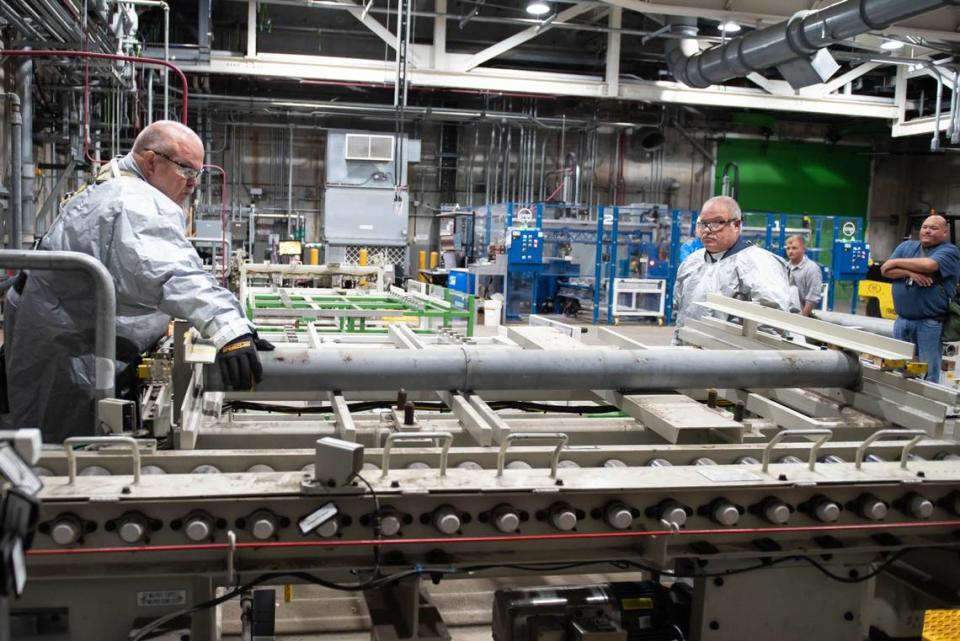Central Kentucky depot is ‘very close’ to destroying chemical weapon stockpile. What’s left
The chemical weapon destruction project at the Blue Grass Army Depot in Richmond is nearly complete, officials close to the project said during a press conference Wednesday.
The Blue Grass Chemical Agent-Destruction Pilot Plant began safely destroying more than 523 tons of chemical agent stored in rockets at Blue Grass Army Depot four years ago on June 7, 2019. The chemical agent was stored in five different types of rockets that had been stored at the depot as early as the 1940s into the mid 1960s.
Four of the five chemical weapons that were stored at the depot have been completely destroyed, according to officials. The last remaining weapon is an M55 rocket containing GB nerve agent. According to the Centers for Disease Control and Prevention, GB nerve agent, otherwise known as sarin, is one of the most toxic chemical agent. Contact with a fraction of an ounce of sarin can be fatal.
As of Friday, 86.9% of that weapon had been destroyed. In total, more than 93% percent of all the weapons at the depot have been destroyed, according to the project’s website.
Through the Chemical Weapons Convention treaty, the United States is mandated by Congress to destroy all chemical weapons stored at the Blue Grass Army Depot and the U.S. Army Pueblo Chemical Depot in Colorado by the end of the year. The U.S. has committed to completing the process by the end of September.
“The two sites are very close to completing the destruction of this stockpile that’s been relics in the United States inventory for many, many decades,” said Michael Abaie, program executive officer for assembled chemical weapons alternatives. “It’s going to be a great milestone, a great achievement for us to get to that point.”
What happens after the destruction is complete?
Abaie said the next phase of the project after complete destruction of the chemical weapons is closure. The Blue Grass Chemical Agent-Destruction Pilot Plant will close in accordance with safety regulations and requirements, a process Abaie expects to take two to three years.
“Closure is really about eliminating the hazard that’s left behind in contaminated areas,” Abaie said. “We will decontaminate those facilities and decommission and ultimately demolish buildings that have been used to process these equipment, munitions.”
The disposition of the remainder of the plant has not yet been determined, according to officials. It will be negotiated by the Department of the Army, the state and the Blue Grass Army Depot.
Madison County Judge-Executive Reagan Taylor hopes the Blue Grass Army Depot stays in Richmond.
“It means a lot to me because I can say that my grandfather was a firefighter at the Blue Grass Army Depot back in the ‘40s,” Taylor said. “It has been a part of our community for a very long time, and it’s my goal, as long as I’m here as judge-executive, to work with the Army and keeping that mission alive for our community.”

How a chemical weapon is safely destroyed
There are two different methods being used to destroy chemical weapons at the Blue Grass Chemical Agent-Destruction Pilot Plant: neutralization and an explosive destruction.
All the nerve agent weapons were destroyed by neutralization. The first nerve agent chemical weapon destroyed at the plant was a 35-inch M426 rocket weighing approximately 200 pounds.
The destruction of the M426 rockets began in January 2020 and was completed four months later. Each rocket was filled with roughly 14.5 pounds of GB nerve agent.
Through neutralization, the nerve agent was drained and separated from the weapon’s explosive components. It was then mixed with hot water and sodium hydroxide to destroy the agent.
Ron Hink, project manager of Bechtel Parsons Blue Grass, said it takes roughly 15 minutes for the agent to be neutralized.
For weapons containing mustard agent, the static detonation center used thermal destruction technology to process the weapons. The chemical agents are pulled from the weapon by automatic equipment and fed into an electronically heated detonation chamber. The high temperatures in the chamber destroy the mustard agent.
According to the CDC, mustard agent, also known as mustard sulfur, is a blister chemical that causes severe burns to areas of contact. It damages cells within minutes of contact.
“That process is remote, so it’s in a blast-proof area, because there’s that potential risk because these are active munitions,” Hink said.
The last remaining weapon needing to be destroyed is an M55 rocket of 78 inches in length and 57 pounds in weight. It contains 10.7 pounds of GB nerve agent.
Hink said rockets with GB agents are the most challenging to destroy because of the condition of the rockets.
“They’ve been well cared for over the years, but they’re just an aging stockpile, and that creates some challenges that we expected,” Hink said.
Despite the handling of hazardous materials, Hink said the Blue Grass Chemical Agent-Destruction Pilot Plant has kept injuries low. The plant has had a reportable incident rate of 0.36% since the project’s beginning and it’s been more than three years since the last reported lost-time injury.
“We are running a hazard facility safer than you can work in a financial institution, an insurance agency or real estate,” Hink said. “Just think about those organizations and when they go to work everyday, they probably don’t give a thought about safety.”
As the project nears its completion, Hink said safety remains a high priority.
“At this stage of the game, we are very focused on day-to-day safe operations,” Hink said. “It’s easy to get distracted at the end. We’re very concerned that that does not happen at this point.”

 Yahoo Sports
Yahoo Sports 